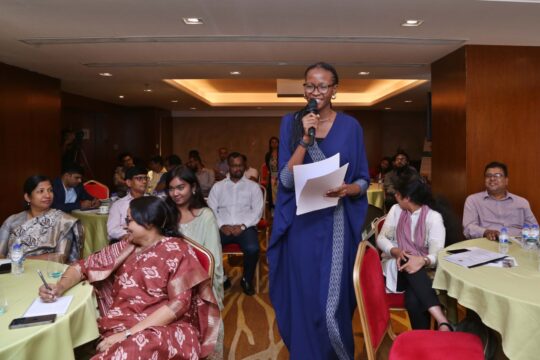
The 7.8 magnitude earthquake in Central Nepal in April 2015 is one of the largest catastrophes in the nation. The mainshock of the event caused 8,510 deaths and 199 missing people. Shakti Gurung was one of many persons displaced as a result of over 400,000 buildings that were fully or partially damaged.
The earthquake highlighted the disproportionate effects of disasters on vulnerable groups for Shakti, “Women primarily lead household activities in Nepal. Despite the risk of collapsing infrastructures, we would have to go to kitchens to prepare meals. I also noticed that the elderly people did not have efficient access to basic needs like sanitation.” Her experience during the earthquake assured her that she had taken the right path to work as a disaster risk reduction and management (DRRM) professional. “My focus is on inclusive and right-based approaches in DRRM. I deliver capacity development training to policymakers and humanitarian actors at the local, district, and province levels.” The Interim Constitution guaranteed 33% of seats to women to improve their paritipcation in politics and policymaking.
Shakti specializes in providing training that emphasizes Gender Equality and Social Inclusion (GESI) and Humanitarian Charter and Minimum Standards in Humanitarian Response (SPHERE) standards. She details her work, “ GESI is essential in sensitizing policymakers to contribute to an inclusive policy and planning process. I advocate on GESI sensitive DRRM policies and policy structures at the federal level. We have also contextualized the SPHERE standards for national purposes. It can now be integrated into the frameworks of all humanitarian actors.” More than 90% of legal frameworks in Nepal promote, enforce, and monitor gender equality under the Sustainable Development Goal (SDG) indicators.
GESI aligns with Shakti’s vision for Nepal. The concept centers on improving access to livelihood assets and services for all. Shakti understands that one of the underlying causes of greater impacts on vulnerable groups is their lack of participation in the risk analysis, planning, and policy formulation processes. There are an estimated 1.9 million people that are highly vulnerable to climate change in Nepal. The director concludes that this gap is rooted at the planning stage, “The needs of vulnerable and marginalized groups’ diverse during humanitarian context is often overlooked.” The Centre for Disaster Management Studies (CDMS) has included GESI in its action plan and conducts monitoring of its application. This endeavor begins from within the organization. “The lead position and board members of the CDMS are held by women. It is a dynamic that supports the active participation of women and excluded groups in all of our events,” states Shakti.

Women must take their socio-cultural responsibilities as a strength according to Shakti – “We have the specific capacities for resource management and are mostly dependent on the threatened natural resources. This is why we are more vulnerable to the impact of climate change.” She wants to see more women take the greater impact as an opportunity to create solutions. “Women have played a vital role in practicing climate-smart technologies, reducing emissions at home using alternative energy sources as well as responding to the crisis. Women in political power have proven to reduce greenhouse gas emissions. Therefore, we can efficiently lead climate change adaptation, mitigation, and response.”
Shakti represents a combination of passion and profession for progress. Outside her work, she is a member secretary of Women Humanitarian and Disaster Risk Reduction Platform – a platform that carries the agenda for fostering women leadership in disaster risk reduction and management. “Equality today for a sustainable tomorrow is ensuring meaningful participation and space as well as equal opportunity for half the world’s population.”
Cover Image: Watch The World/ @Shutterstock.com.


